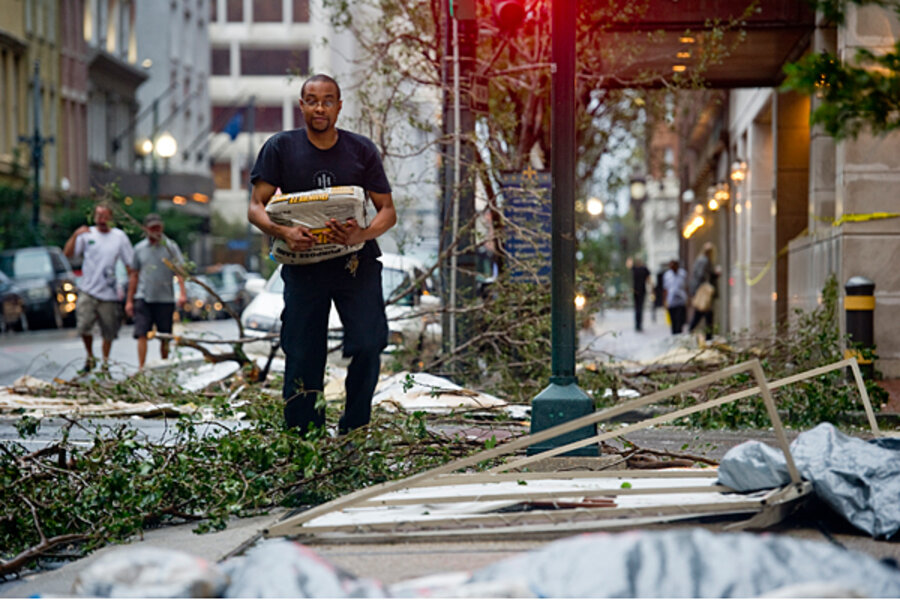Hurricane Isaac aftermath: Will FEMA have enough money?
Loading...
The US spent $141 billion for cleanup and recovery after hurricane Katrina hit in 2005.
How much will hurricane Isaac cost?
While it is too early to know the answer, experts say it would not be surprising if the Federal Emergency Management Agency (FEMA) needs to ask Congress for more money once it assesses the damage from the storm.
“It would not surprise me at all,” says Albert Ashwood, former president of the National Emergency Management Association and the emergency management director of Oklahoma. “The potential is there – I know I talked to the Emergency Director of Arkansas, and they are very concerned about flooding.”
The total funding needs will depend on the amount of damage to public infrastructure. “The cost estimates come after the storm passes and officials can get people safely back to their homes,” says David Maurstad, a former FEMA regional administrator. “That’s a couple of weeks down the road.”
FEMA Administrator Craig Fugate says the agency is in good shape for the initial response to Isaac. “We are very healthy with those funds going into this storm,” said Mr. Fugate on CNN on Wednesday morning. “Unlike last year we had a lot of problems with that money, Congress and the president agreed to fully fund these accounts so going into this storm we’re in good shape for response.”
Fugate was mainly referring to the money needed for the initial response to the storm, such as pre-positioning supplies and personnel, says a FEMA official who requested that his name be withheld because he is not authorized to speak to the press about agency policy. Fugate was not referring to the amount of money needed for recovery, the official says.
The agency had $1.515 billion in its Disaster Relief Fund as of Wednesday morning, the official says. But that money won’t be earmarked only for Isaac relief and recovery.
“Most states have open disasters out there,” says Mr. Ashwood, referring to disasters where the state has asked FEMA for money but has not received it yet. “If you have to rebuild a bridge or a large road, that takes time.”
Hurricane Katrina which devastated Louisiana and Mississippi in 2005, illustrates how long it can take to find out the total cost of a storm. Congress continued spending money on levee and sea wall construction for at least three years afterward.
After major disasters, FEMA often has to go back to Congress to ask for more money to help pay for washed out bridges, public facilities that have lost roofs, or the rebuilding of a road.
In the past, getting supplemental money from Congress was relatively easy. For example, in fiscal year 2006, after hurricanes Katrina and Rita, Congress approved an additional $19.8 billion to help pay for levee rehabilitation, debris removal, and many other expenses.
But last year, some Republicans in the House balked when FEMA asked for additional funding because of a spate of natural disasters. They wanted cuts in other programs to offset the money FEMA needed. The standoff passed, however, and FEMA ultimately got its money.
“Up until the Republicans took the House in 2011, it was normal to pass an emergency supplemental spending bill every spring,” says economist Pete Davis, who advises Wall Street clients and formerly worked on the Hill. “But the House ended the emergency supplementals since the general view is that it is pork.”
This year the number of declared disasters is down compared with last year. In FY 2011, there were 99 major disasters. So far in FY2012, according to FEMA, there have been 31 major disasters. On Thursday, President Obama declared a major disaster for Louisiana and Mississippi.
This year, notes Mr. Davis, “There are a lot more wildfires than normal.”
Oklahoma's Ashwood can attest to that. This summer, 603 homes in four Oklahoma counties were lost to the raging fires. Some 85 percent of the homeowners did not have insurance. Many lived in rural areas and mobile homes. Ashwood says he has become frustrated with FEMA, which decided it would fund the homes lost in one county but not the other three.
“They decided 373 needed help and the rest did not. I don’t quite understand that,” he says.
In a letter to the state, Fugate wrote that the damaged areas were “not of such severity and magnitude to warrant the designation of Individual Assistance” for the three counties.





